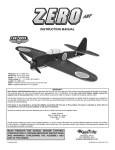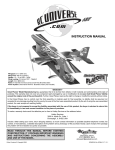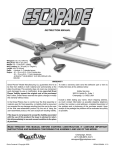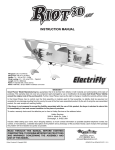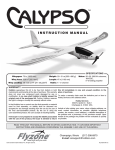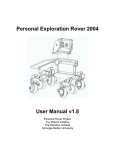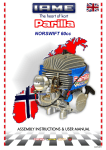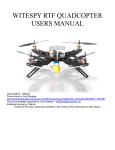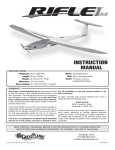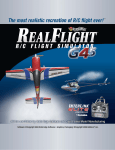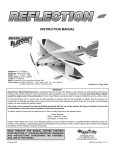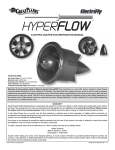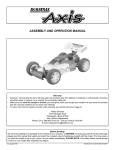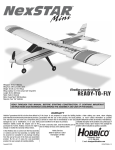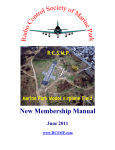Download Manual 1
Transcript
3D EP with FlightFlex™ INSTRUCTION MANUAL Wingspan: 33.5 in [850mm] 2 Wing Area: 369 sq in [24 dm ] Weight: 16-17 oz [455–480g] 2 Wing Loading: 6.2–6.6oz/sq ft [19–20 g/dm ] Length: 36.5 in [925mm] Radio: 4-channel w/ 4 micro servos and 25A brushed ESC Power System: Ball-bearing 370-sized motor, 5:1 reduction gearbox (included) WARRANTY Great Planes® Model Manufacturing Co. guarantees this kit to be free from defects in both material and workmanship at the date of purchase. This warranty does not cover any component parts damaged by use or modification. In no case shall Great Planes’ liability exceed the original cost of the purchased kit. Further, Great Planes reserves the right to change or modify this warranty without notice. In that Great Planes has no control over the final assembly or material used for final assembly, no liability shall be assumed nor accepted for any damage resulting from the use by the user of the final user-assembled product. By the act of using the user-assembled product, the user accepts all resulting liability. If the buyer is not prepared to accept the liability associated with the use of this product, the buyer is advised to return this kit immediately in new and unused condition to the place of purchase. To make a warranty claim send the defective part or item to Hobby Services at the address below: Hobby Services 3002 N. Apollo Dr. Suite 1 Champaign IL 61822 USA Include a letter stating your name, return shipping address, as much contact information as possible (daytime telephone number, fax number, e-mail address), a detailed description of the problem and a photocopy of the purchase receipt. Upon receipt of the package the problem will be evaluated as quickly as possible. READ THROUGH THIS MANUAL BEFORE STARTING CONSTRUCTION. IT CONTAINS IMPORTANT WARNINGS AND INSTRUCTIONS CONCERNING THE ASSEMBLY AND USE OF THIS MODEL. © Copyright 2005 Champaign, Illinois (217) 398-8970, Ext 5 [email protected] GPMZ0181 for GPMA1274 V1.0 TABLE OF CONTENTS INTRODUCTION Whether you’re just learning aerobatics or are a seasoned 3D veteran, you’ll enjoy the Yak 55 EP w/ FlightFlex. This airplane combines the proven flight characteristics of the Yak 55 design in an inexpensive, easy-to-operate electric powered model with an extremely resilient structure. When your airplane is capable of bouncing back from unintended impacts with terra firma, it’s just that much easier to learn to do maneuvers like torque rolls, harriers, high-alpha rolls, etc. INTRODUCTION ................................................................2 SAFETY PRECAUTIONS ..................................................3 ADDITIONAL ITEMS REQUIRED .....................................3 Radio Equipment .........................................................3 Adhesives and Building Supplies.................................4 The EPP material that this Yak 55 is made of allows it to bounce back from most crashes – just pick it up, dust it off, and launch it again. Just because the airplane is capable of withstanding crashes doesn’t mean it is completely indestructible, however. If you drive the airplane straight down into the ground at full throttle, you will probably be making some repairs. To minimize damage, cut the throttle before impact if possible. Optional Supplies and Tools ........................................4 COMMON ABBREVIATIONS ............................................4 IMPORTANT BUILDING NOTES.......................................4 KIT CONTENTS.................................................................5 ORDERING REPLACEMENT PARTS...............................6 Take care to build straight and true as you complete the airplane. Misaligned parts will hurt the airplane’s ability to perform the extreme aerobatics it is designed for. BUILDING INSTRUCTIONS ..............................................7 Assemble the Airframe ................................................7 For the latest technical updates or manual corrections to the Yak 55 EP with FlightFlex, visit the Great Planes web site at www.greatplanes.com. Open the “Airplanes” link and then select the Yak 55. If there is new technical information or changes to this model, a “tech notice” box will appear in the upper left corner of the page. Set Up the Radio System ............................................9 Install the Propulsion System ....................................11 GET THE MODEL READY TO FLY ................................12 Check the Control Directions .....................................12 Set the Control Throws ..............................................13 Balance the Model (C.G.) ..........................................13 AMA Balance the Model Laterally ......................................14 We urge you to join the AMA (Academy of Model Aeronautics) and a local R/C club. The AMA is the governing body of model aviation and membership is required to fly at AMA clubs. Though joining the AMA provides many benefits, one of the primary reasons to join is liability protection. Coverage is not limited to flying at contests or on the club field. It even applies to flying at public demonstrations and air shows. Failure to comply with the Safety Code (excerpts printed in the back of the manual) may endanger insurance coverage. Additionally, training programs and instructors are available at AMA club sites to help you get started the right way. There are over 2,500 AMA chartered clubs across the country. Contact the AMA at the address or toll-free phone number below: PREFLIGHT .....................................................................14 Identify Your Model.....................................................14 Charge the Batteries..................................................14 Balance Propellers.....................................................14 Range Check .............................................................14 MOTOR SAFETY PRECAUTIONS ..................................14 AMA SAFETY CODE ......................................................14 Academy of Model Aeronautics 5151 East Memorial Drive Muncie, IN 47302-9252 Tele. (800) 435-9262 Fax (765) 741-0057 Or via the Internet at: http://www.modelaircraft.org CHECK LIST....................................................................15 FLYING.............................................................................15 Hand Launch ................................................back cover Flight .............................................................back cover IMPORTANT!!! Two of the most important things you can do to preserve the radio controlled aircraft hobby are to avoid flying near full-scale aircraft and avoid flying near or over groups of people. Landing .........................................................back cover ID tag ............................................................back cover 2 LITHIUM BATTERY SAFETY PROTECT YOUR MODEL, YOURSELF & OTHERS...FOLLOW THESE IMPORTANT SAFETY PRECAUTIONS WARNING!! Read the entire instruction sheet included with the battery. Failure to follow all instructions could cause permanent damage to the battery and its surroundings, and cause bodily harm! 1. Your YAK 55 should not be considered a toy, but rather a sophisticated, working model that functions very much like a fullsize airplane. Because of its performance capabilities, the YAK 55, if not assembled and operated correctly, could possibly cause injury to yourself or spectators and damage to property. • ONLY use a LiPo approved charger. NEVER use a NiCd/NiMH peak charger! • NEVER charge in excess of 4.20V per cell. 2. You must assemble the model according to the instructions. Do not alter or modify the model, as doing so may result in an unsafe or unflyable model. In a few cases the instructions may differ slightly from the photos. In those instances the written instructions should be considered as correct. • ONLY charge through the “charge” lead. NEVER charge through the “discharge” lead. 3. You must take time to build straight, true and strong. • ALWAYS charge in a fireproof location. • NEVER charge at currents greater than 1C. • ALWAYS set charger’s output volts to match battery volts. • NEVER trickle charge. 4. You must use an R/C radio system that is in first-class condition with a correctly sized motor and components throughout the building process. • NEVER allow the battery temperature to exceed 150°F (65° C). • NEVER disassemble or modify pack wiring in any way or puncture cells. 5. You must correctly install all R/C and other components so that the model operates correctly on the ground and in the air. • NEVER discharge below 2.5V per cell. 6. You must check the operation of the model before every flight to insure that all equipment is operating and that the model has remained structurally sound. Be sure to check clevises or other connectors often and replace them if they show any signs of wear or fatigue. • NEVER place on combustible materials or leave unattended during charge or discharge. • ALWAYS KEEP OUT OF REACH OF CHILDREN. 7. If you are not an experienced pilot or have not flown this type of model before, we recommend that you get the assistance of an experienced pilot in your R/C club for your first flights. If you’re not a member of a club, your local hobby shop has information about clubs in your area whose membership includes experienced pilots. ADDITIONAL ITEMS REQUIRED Radio Equipment and Electronics NOTE: Recommended part numbers are included in parentheses. ❏ ❏ ❏ ❏ ❏ ❏ ❏ ❏ We, as the kit manufacturer, provide you with a top quality, thoroughly tested kit and instructions, but ultimately the quality and flyability of your finished model depends on how you build it; therefore, we cannot in any way guarantee the performance of your completed model, and no representations are expressed or implied as to the performance or safety of your completed model. ❏ Remember: Take your time and follow the instructions to end up with a well-built model that is straight and true. 3 4-channel radio minimum (for maximum 3D performance, a computer radio with mixing is recommended) 4 sub-micro servos ( 0.3 oz [9g] or less each) (FUTM0042) Micro receiver (FUTL0442-3) Servo Y-harness (FUTM4130) two 6” Servo extensions (HCAM2000) two 12” Servo extensions (HCAM2100) 25-amp brushed ESC (GPMM2025) 1250 - 1500mAh 3-series Lithium Polymer battery pack (GPMP0823) (GPMP0831) Lithium Polymer Charger... Great Planes Triton Charger (GPMP3150) or Great Planes Polycharger (GPMM3010) Adhesives and Building Supplies IMPORTANT BUILDING NOTES In addition to common household tools and hobby tools, this is the “short list” of the most important items required to build the YAK 55. Great Planes Pro™ Foam Safe CA is recommended. • When you see the term test fit in the instructions, it means that you should first position the part on the assembly without using any glue, then slightly modify or custom fit the part as necessary for the best fit. ❏ Low-temperature, hot-melt glue gun and glue ❏ ❏ ❏ • Whenever the term glue is written, you should rely upon your experience to decide what type of glue to use.When a specific type of adhesive works best for that step, the instructions will make a recommendation. Since this model is constructed from foam, we recommend the use of foam-safe CA glues and epoxy only. Do not use standard CA glue on this model as it will dissolve the structure. (WOOU1445/WOOU1446) Hobby knife with #11 blade (HCAR0105) Thin, Foam Safe-CA (GPMR6069) Threadlocker cement (GPMR6060) Optional Supplies and Tools • Photos and sketches are placed before the step they refer to. Frequently you can study photos in following steps to get another view of the same parts. Here is a list of optional tools mentioned in the manual that will help you build the Great Planes Yak 55. ❏ ❏ ❏ Great Planes CG Machine™ (GPMR2400) Household string Common straight pin COMMON ABBREVIATIONS Fuse Fin LE TE LG Ply Stab " SHCS mm = Fuselage = Vertical Fin = Leading Edge = Trailing Edge = Landing Gear = Plywood = Horizontal Stabilizer = Inches = Socket Head Cap Screw = Millimeters To convert inches to millimeters, multiply inches by 25.4 (25.4mm = 1”) 4 KIT INSPECTION Before starting to build, take an inventory of this kit to make sure it is complete, and inspect the parts to make sure they are of acceptable quality. If any parts are missing or are not of acceptable quality, or if you need assistance with assembly, contact Product Support. When reporting defective or missing parts, use the part names exactly as they are written in the Kit Contents list. Great Planes Product Support: 3002 N Apollo Drive, Suite 1 Champaign, IL 61822 Telephone: (217) 398-8970, ext. 5 Fax: (217) 398-7721 E-mail: [email protected] KIT CONTENTS 1 7 2 8 3 9 4 10 5 11 6 12 Kit Contents (Photographed) 1 2 3 4 5 6 Fuselage Cowl Elevator joiner tube Propeller Prop saver O-ring Motor/Gear drive 7 8 9 10 11 12 Rudder Hardware Elevators Wing Right aileron Left aileron Kit Contents (Not Photographed) 1 x 130mm [1/32" x 5"] Carbon aileron pushrods (2) 1 x 15mm [1/32" x 5/8"] Carbon rudder pushrod (1) 1 x 80mm [1/32" x 3-1/8"] Carbon elevator pushrod (1) Hook & loop fasterner (1) Gearbox screw 2 x 6mm [#2 x 1/4"] (1) 5 ORDERING REPLACEMENT PARTS Replacement parts for the Great Planes YAK 55 EP w/FlightFlex are available using the order numbers in the Replacement Parts List that follows. The fastest, most economical service can be provided by your hobby dealer or mail-order company. To locate a hobby dealer, visit the Hobbico web site at www.hobbico.com. Choose “Where to Buy” at the bottom of the menu on the left side of the page. Follow the instructions provided on the page to locate a U.S., Canadian or International dealer. If a hobby shop is not available, replacement parts may also be ordered from Tower Hobbies® at www.towerhobbies.com, or by calling toll free (800) 637-6050. Parts may also be ordered directly from Hobby Services by calling (217) 398-0007, or via facsimile at (217) 398-7721, but full retail prices and shipping and handling charges will apply. Illinois and Nevada residents will also be charged sales tax. If ordering via fax, include a Visa® or MasterCard® number and expiration date for payment. Mail parts orders and payments by personal check to: Hobby Services 3002 N Apollo Drive, Suite 1 Champaign IL 61822 Be certain to specify the order number exactly as listed in the Replacement Parts List. Payment by credit card or personal check only; no C.O.D. If additional assistance is required for any reason contact Product Support by e-mail at [email protected], or by telephone at (217) 398-8970. Because the Yak 55 is built as a one-piece airframe, there are no replacement airframe parts available. Replacements for small parts are available. REPLACEMENT PARTS LIST ORDER NUMBER DESCRIPTION HOW TO PURCHASE GPMG0215.....................................GEAR DRIVE.................................Hobby Supplier GPMG0860...............REPLACEMENT SHAFT W/SPUR GEAR...........Hobby Supplier GPMG0239 ....................................PINION GEAR ................................Hobby Supplier GPMG0311 ...........................REPLACEMENT MOTOR .......................Hobby Supplier GPMA2786..............................11 X 4.7 PROPELLER..........................Hobby Supplier GPMQ4620 ....................................PROP SAVER ................................Hobby Supplier GPMA2785 .................................HARDWARE BAG .............................Hobby Supplier GPMG0216....................MOTOR/GEAR DRIVE ASSEMBLY................Hobby Supplier GPMA2743...........................................COWL.......................................Hobby Supplier GPMA2740 ...........................................WING .......................................Hobby Supplier GPMA2741 ......................................FUSELAGE ..................................Hobby Supplier GPMA2742 ........................................TAIL SET ....................................Hobby Supplier Missing pieces....................Contact Product Support Instruction manual.................Contact Product Support Full-size plans .............................Not available 6 Use the glue-gun tip to re-melt the glue bead, causing it to penetrate into the joint and form into a fillet. The gun tip will also slightly melt the foam, allowing the glue to fuse with it somewhat, forming a very strong joint. BUILDING INSTRUCTIONS Assemble the Airframe CENTER A=A STRING A A B B B=B 90 degrees A=A A A ❏ 1. Slide the horizontal stabilizer into the slot at the rear of the fuselage. Check the alignment using the sketch above as a reference. Use a common pin to secure a length of string to the front center of the fuselage. Adjust the position of the stab in the stab slot until the length of string is equal on both ends of the stab. Be careful not to flex the fuselage as you make measurements. ❏ 3. Slide the wing into the cutout in the fuselage. Make sure the wing is centered and square in the fuselage, and parallel with the stabilizer when viewed from the front. Again, be careful not to flex the fuselage as you make your measurements. ❏ 2. When you are satisfied with the alignment of the stabilizer, glue it in place with low-temperature hot-melt glue. ❏ 4. When you are satisfied with the alignment of the wing, glue it in place with hot-melt glue. When gluing EPP parts together with hot-melt glue, you can use this technique to create a very strong bond if the parts form an angle between them. ❏ 5. Use hot-melt glue to secure four hinges in the precut slots in each aileron. Do not worry about a little excess glue squeezing out onto the hinge pivots—it is easily removed with a hobby knife after the glue hardens. Run a small bead in the corner between the two parts. 7 ❏ 9. Use a hobby knife to clean any excess glue from the hinges. ❏ 6. Test fit the ailerons to the wings. If necessary, enlarge the precut hinge slots with a hobby knife. ❏ 10. Slide the 3mm [1/8"] carbon elevator joiner tube into the plastic tubes on the stabilizer. Make sure it is centered. ❏ 7. Glue the outermost hinge into the wing, making sure to keep the hinge line parallel with the TE of the wing. ❏ 11. Run a small bead of hot-melt glue into the groove on the leading edge of an elevator half. Run the glue-gun tip back through the bead to re-melt and spread it, and press the elevator half onto the joiner tube. ❏ 8. Using the flex of the aileron to allow you to glue one hinge in at a time, work your way inward until all four hinges are glued in place. ❏ 12. Repeat the previous step with the other elevator half, making sure to keep the elevator halves aligned with each other. 8 Set Up the Radio System ❏ 5. Cut a slot in the left elevator half in the location shown. The front of the slot is just aft of the carbon tube. The plane is shown here upside down. ❏ 1. Secure a 6” [152mm] extension to each of your aileron servos with tape or heat-shrink tubing. Use the strings in the wings to pull the leads through into the cockpit area. ❏ 2. Use hot-melt glue to glue the servos into the wing cutouts with the output shafts forward. ❏ 6. Cut a slot in the rudder in the location shown. The front of the slot is even with the start of the hinge bevel on the rudder. ❏ 3. Secure 12” [305mm] extensions to your elevator and rudder servos using tape or heat shrink tubing. Use the string in the fuselage to pull both servo leads into the cockpit area. ❏ 4. Glue the tail servos into the cutout in the fuselage with hot-melt glue. Both servos should have their output shafts toward the front of the airplane, and the lower servo should project out the left side of the plane, while the upper servo projects out the right side. ❏ 7. Cut a slot in each aileron in the location shown. The front of the slots are even with the start of the hinge bevels on the ailerons. 9 ❏ ❏ 11. Install a control horn into the right side of the rudder using the same procedure. 8. Press a plastic z-bend clevis into each of the four control horns. Trim the inside of the hole in the control horn to ease the installation of the clevis. ❏ 12. Install control horns in the underside of the ailerons using the same procedure. ❏ 13. If necessary, remove the servo arms from all of your servos. Find 4 long output arms with the spline size that fits your servos. Press a plastic z-bend clevis into the outer hole on each of these arms. Trim the hole in the arm to ease the installation of the clevis. ❏ 9. Glue a control horn into the underside of the elevator half. Position the control horn as far forward as possible. ❏ 14. Install the receiver and ESC into the fuselage. Plug the servos into the receiver and temporarily install the battery into the fuselage. Center all servos with your radio. ❏ 10. Secure the back side of the control horn with a control horn retainer. Secure it with a small bead of glue. ❏ 15. Attach the servo arm to the elevator servo pointing straight up. Secure the arm with the screw included with the 10 servo. Slide a 3-1/8" X 1/32" [80mm x 1mm] carbon rod through the clevises on the servo and the control horn. Adjust the linkage by sliding the rod in the clevises until you have the elevator straight when the servo is centered. Once you are satisfied with the linkage, secure it with a small drop of thin CA between the clevises and the rod. Be very careful not to get CA in the pivoting joint between the horns and the clevises. Install the Propulsion System ❏ 1. Pull the ESC output wires forward from the canopy and out the hole in the firewall using the preinstalled string if necessary. ❏ 16. Set up the rudder linkage using the same technique. ❏ 2. Connect your ESC output wires to the motor. If using a different ESC than the one recommended, soldering may be necessary. If soldering, attach the wires to the same point that the capacitors and brush wires are pre-soldered to. The positive wire from the ESC connects to the identified red post. Check for proper rotation before proceeding. ❏ 17. Set up the aileron linkages using the same techniques. In this case, both servo arms should be installed perpendicular to the fuselage when the ailerons are in the neutral position. This will create a small amount of aileron differential. ❏ 18. Check that all of the servo arm screws are installed in the servos. ❏ 3. Slide the gearbox assembly onto the motor stick. Align the front of the gearbox 1-3/4" [44mm] from the firewall and secure it with a 2 x 6mm [#2 x 1/4"] wood screw. 11 ❏ 7. Secure the propeller to the prop saver using one of the included o-rings. ❏ 4. Test fit the prop saver against the hub of the included propeller. The proper fitting side faces forward when installed. Slide the prop saver onto the gearbox output shaft. Make sure that the screws seat down into the two flat spots on the shaft. Secure the screws with threadlocking compound. ❏ 8. Install the receiver behind the battery using hook and loop fastener. Run the antenna out the back of the zippered fuselage opening. Use a pin to puncture two holes 1/2" [12mm] apart in the vertical fin. Stick the receiver antenna through the holes as shown. ❏ 9. The ESC can be tucked into the front of the fuselage on either side of the battery. ❏ GET THE MODEL READY TO FLY 5. Install the cowl onto the nose. Secure it with 4 small drops of hot glue. This will make it easy to remove if needed for motor maintenance or replacement. Check the Control Directions ❏ 1. Turn on the transmitter and receiver and center the trims. If necessary, remove the servo arms from the servos and reposition them so they are centered. Reinstall the screws that hold on the servo arms. ❏ 2. With the transmitter and receiver still on, check all the control surfaces to see if they are centered. 4-CHANNEL RADIO SETUP (STANDARD MODE 2) 4-CHANNEL TRANSMITTER ELEVATOR MOVES UP ❏ 6. Cut off a 1" piece of the hook and loop material (used 4-CHANNEL TRANSMITTER RIGHT AILERON MOVES UP LEFT AILERON MOVES DOWN to install the receiver in step 8). Install the remaining hook side of the hook and loop fastener into the battery compartment. Stick the remaining loop side onto the battery pack. The pack will sit on its side in the fuselage. ❏ 4-CHANNEL TRANSMITTER RUDDER MOVES RIGHT 4-CHANNEL TRANSMITTER FULL THROTTLE 3. Make certain that the control surfaces and the motor respond in the correct direction as shown in the diagram. If any 12 of the controls respond in the wrong direction, use the servo reversing in the transmitter to reverse the servos connected to those controls. Be certain the control surfaces have remained centered. Adjust if necessary. Set the Control Throws Use a ruler to accurately measure and set the control throw of each control surface as indicated in the chart that follows. If your radio does not have dual rates, we recommend setting the throws between the high and low rate setting. NOTE: The throws are measured at the widest part of the elevators, rudder and ailerons. These are the recommended control surface throws: ELEVATOR RUDDER AILERONS High Rate/3D 3" [76mm] up 3" [76mm] down Low Rate 1-1/2" [19mm] up 1-1/2" [19mm] down 4-1/2" [114mm] right 4-1/2" [114mm] left 1-1/2" [38mm] right 1-1/2" [38mm] left 2-5/8" [67mm] up 2" [51mm] down 1" [25.4mm] up 7/8" [22mm] down ❏ 1. Use a felt-tip pen or 1/8” [3mm]-wide tape to accurately mark the C.G. on the top of the wing on both sides of the fuselage. The C.G. is located 3-3/8” [86mm] back from the leading edge of the wing at the fuselage. This is where your model should balance for the first flights. Later, you may wish to experiment by shifting the C.G. up to 1/2” [13mm] forward or 3/8” [9mm] back to change the flying characteristics. Moving the C.G. forward may improve the smoothness and stability, but the model may then require more speed for takeoff and make it more difficult to slow for landing. Moving the C.G. aft makes the model more maneuverable, but could also cause it to become too difficult to control. In any case, start at the recommended balance point and do not at any time balance the model outside the specified range. Note: High rates are 3D rates. IMPORTANT: The YAK 55 EP w/ FlightFlex has been extensively flown and tested to arrive at the throws at which it flies best. Flying your model at these throws will provide you with the greatest chance for successful first flights. If, after you have become accustomed to the way the YAK 55 flies, you would like to change the throws to suit your taste, that is fine. However, too much control throw could make the model difficult to control, so remember, “more is not always better.” ❏ 2. With all parts of the model installed, including the battery (ready to fly) lift it upside-down on your fingertips at the balance point you marked. ❏ 3. If the tail drops, the model is “tail heavy” and the battery pack and/or receiver must be shifted forward or weight must be added to the nose to balance. If the nose drops, the model is “nose heavy” and the battery pack and/or receiver must be shifted aft or weight must be added to the tail to balance. If possible, relocate the battery pack and receiver to minimize or eliminate any additional ballast required. If additional weight is required, begin by placing incrementally increasing amounts of weight on the bottom of the fuse until the model balances. Once you have determined the amount of weight required, it can be permanently attached. Balance the Model CG More than any other factor, the C.G. (balance point) can have the greatest effect on how a model flies, and may determine whether or not your first flight will be successful. If you value this model and wish to enjoy it for many flights, DO NOT OVERLOOK THIS IMPORTANT PROCEDURE. A model that is not properly balanced will be unstable and possibly unflyable. At this stage the model should be in ready-to-fly condition with all of the systems in place including the engine, landing gear, covering and paint, and the radio system. IMPORTANT: If you found it necessary to add any weight, recheck the C.G. after the weight has been permanently installed. 13 Balance the Model Laterally Range Check Ground check the operational range of your radio before the first flight of the day. With the transmitter antenna collapsed and the receiver and transmitter on, you should be able to walk at least 100 feet away from the model and still have control. Have an assistant stand by your model and, while you work the controls, tell you what the control surfaces are doing. Repeat this test with the motor running at various speeds with an assistant holding the model, using hand signals to show you what is happening. If the control surfaces do not respond correctly, do not fly! Find and correct the problem first. Look for loose servo connections or broken wires, corroded wires on old servo connectors, poor solder joints in your battery pack or a defective cell, or a damaged receiver crystal from a previous crash. ❏ 1. With the wing level, have an assistant help you lift the model by the motor propeller shaft and the bottom of the fuse under the TE of the fin. Do this several times. ❏ 2. If one wing always drops when you lift the model, it means that side is heavy. Balance the airplane by adding weight to the other wing tip. An airplane that has been laterally balanced will track better in loops and other maneuvers. PREFLIGHT Identify your Model No matter if you fly at an AMA sanctioned R/C club site or if you fly somewhere on your own, you should always have your name, address, telephone number and AMA number on or inside your model. It is required at all AMA R/C club flying sites and AMA sanctioned flying events. MOTOR SAFETY PRECAUTIONS Failure to follow these safety precautions may result in severe injury to yourself and others. Charge the Batteries Keep your face and body as well as all spectators away from the plane of rotation of the propeller whenever the battery is connected. Follow the battery charging instructions that came with your radio control system to charge the batteries. You should always charge your transmitter and airplane batteries the night before you go flying, and at other times as recommended by the radio manufacturer. Keep these items away from the prop: loose clothing, shirt sleeves, ties, scarfs, long hair or loose objects such as pencils or screwdrivers that may fall out of shirt or jacket pockets into the prop. CAUTION: Unless the instructions that came with your radio system state differently, the initial charge on new transmitter and receiver batteries should be done for 15 hours using the slow-charger that came with the radio system. This will “condition” the batteries so that the next charge may be done using the fast-charger of your choice. If the initial charge is done with a fast-charger the batteries may not reach their full capacity and you may be flying with batteries that are only partially charged. AMA SAFETY CODE (EXCERPTS) Read and abide by the following excerpts from the Academy of Model Aeronautics Safety Code. For the complete Safety Code refer to Model Aviation magazine, the AMA web site or the Code that came with your AMA license. GENERAL 1) I will not fly my model aircraft in sanctioned events, air shows, or model flying demonstrations until it has been proven to be airworthy by having been previously, successfully flight tested. 2) I will not fly my model aircraft higher than approximately 400 feet within 3 miles of an airport without notifying the airport operator. I will give right-of-way and avoid flying in the proximity of full-scale aircraft. Where necessary, an observer shall be utilized to supervise flying to avoid having models fly in the proximity of full-scale aircraft. 3) Where established, I will abide by the safety rules for the flying site I use, and I will not willfully and deliberately fly my models in a careless, reckless and/or dangerous manner. 5) I will not fly my model unless it is identified with my name and address or AMA number, on or in the model. Note: This does not apply to models while being flown indoors. 7) I will not operate models with pyrotechnics (any device that explodes, burns, or propels a projectile of any kind). Balance Propellers Carefully balance your propeller and spare propellers before you fly. An unbalanced prop can be the single most significant cause of vibration that can damage your model. Vibration may also damage your radio receiver and battery. We use a Top Flite Precision Magnetic Prop Balancer™ (TOPQ5700) in the workshop and keep a Great Planes Fingertip Prop Balancer (GPMQ5000) in our flight box. 14 ❏ RADIO CONTROL 1) I will have completed a successful radio equipment ground check before the first flight of a new or repaired model. 2) I will not fly my model aircraft in the presence of spectators until I become a qualified flyer, unless assisted by an experienced helper. 3) At all flying sites a straight or curved line(s) must be established in front of which all flying takes place with the other side for spectators. Only personnel involved with flying the aircraft are allowed at or in the front of the flight line. Intentional flying behind the flight line is prohibited. 4) I will operate my model using only radio control frequencies currently allowed by the Federal Communications Commission. 5) I will not knowingly operate my model within three miles of any pre-existing flying site except in accordance with the frequency sharing agreement listed [in the complete AMA Safety Code]. 9) Under no circumstances may a pilot or other person touch a powered model in flight; nor should any part of the model other than the landing gear, intentionally touch the ground, except while landing. ❏ ❏ ❏ ❏ ❏ 7. Secure connections between servo wires and Y-connectors or servo extensions, and the connection between your battery pack and the on/off switch with vinyl tape, heat shrink tubing or special clips suitable for that purpose. 8. Make sure any servo extension cords you may have used do not interfere with other systems (servo arms, pushrods, etc.). 9. Balance your propeller (and spare propellers). 10. Place your name, address, AMA number and telephone number on or inside your model. 11. If you wish to photograph your model, do so before your first flight. 12. Range check your radio when you get to the flying field. FLYING The YAK 55 is a great-flying model that flies smoothly and predictably. The YAK 55 does not, however, possess the selfrecovery characteristics of a primary R/C trainer and should be flown only by experienced R/C pilots. CAUTION (THIS APPLIES TO ALL R/C AIRPLANES): If, while flying, you notice an alarming or unusual sound such as a low-pitched “buzz,” this may indicate control surface flutter. Flutter occurs when a control surface (such as an aileron or elevator) or a flying surface (such as a wing or stab) rapidly vibrates up and down (thus causing the noise). In extreme cases, if not detected immediately, flutter can actually cause the control surface to detach or the flying surface to fail, thus causing loss of control followed by an impending crash. The best thing to do when flutter is detected is to slow the model immediately by reducing power, then land as soon as safely possible. Identify which surface fluttered (so the problem may be resolved) by checking all the servo grommets for deterioration or signs of vibration. Make certain all pushrod linkages are secure and free of play. If it fluttered once, under similar circumstances it will probably flutter again unless the problem is fixed. Some things which can cause flutter are; Excessive hinge gap; Not mounting control horns solidly; Poor fit of clevis pin in horn; Side-play of wire pushrods caused by large bends; Excessive free play in servo gears; Insecure servo mounting; and one of the most prevalent causes of flutter; Flying an over-powered model at excessive speeds. CHECK LIST During the last few moments of preparation your mind may be elsewhere anticipating the excitement of the first flight. Because of this, you may be more likely to overlook certain checks and procedures that should be performed before the model is flown. To help avoid this, a check list is provided to make sure these important areas are not overlooked. Many are covered in the instruction manual, so where appropriate, refer to the manual for complete instructions. Be sure to check the items off as they are completed. ❏ 1. Check the C.G. according to the measurements provided in the manual. ❏ 2. Be certain the battery and receiver are securely mounted in the fuse. Simply stuffing them into place with foam rubber is not sufficient. ❏ 3. Extend your receiver antenna and make sure it has a strain relief inside the fuselage to keep tension off the solder joint inside the receiver. ❏ 4. Balance your model laterally as explained in the instructions. ❏ 5. Make sure all hinges are securely glued in place. ❏ 6. Confirm that all controls operate in the correct direction and the throws are set up according to the manual. 15 Hand Launch For the first flight, it is a good idea to have a friend launch the airplane for you.This allows you to keep your hands on the radio sticks and correct any trim problems that are present. Have your friend hold the YAK 55 by the canopy. Throttle up to full power, and have your friend give the plane a gentle underhanded toss at about a 30-degree angle upward. Since the YAK 55 has a very high thrust to weight ratio, the plane will accelerate to flying speed almost instantly. Climb to a comfortable altitude and throttle back to a lower power setting. This plane flies great at about half-throttle when in standard forward flight. Flight For reassurance and to keep an eye on other traffic, it is a good idea to have an assistant on the flight line with you. Tell him to remind you to throttle back once the plane gets to a comfortable altitude. While full throttle is usually desirable for takeoff, most models fly more smoothly at reduced speeds. Take it easy with the Great Planes Yak 55 for the first few flights, gradually getting acquainted with it as you gain confidence. Adjust the trims to maintain straight and level flight. After flying around for a while, and while still at a safe altitude with plenty of battery power remaining, practice slow flight and execute practice landing approaches by reducing the throttle to see how the model handles at slower speeds. Add power to see how the Yak 55 climbs as well. Continue to fly around, executing various maneuvers and making mental notes (or having your assistant write them down) of what trim or C.G. changes may be required to fine tune the model so it flies the way you like. Mind your battery power, but use this first flight to become familiar with your model before landing. Landing AMA number Phone number City, State Zip Address Name This model belongs to: To initiate a landing approach, lower the throttle while on the downwind leg. Allow the nose of the model to pitch downward to gradually bleed off altitude. Continue to lose altitude, but maintain airspeed by keeping the nose down as you turn onto the crosswind leg. Make your final turn toward the landing area (into the wind) keeping the nose down to maintain airspeed and control. Level the attitude when the model reaches an altitude of about 10 feet, modulating the throttle as necessary to maintain your glide path and airspeed. If you are going to overshoot, smoothly advance the throttle (always ready on the right rudder to counteract torque) and climb out to make another attempt. When you’re ready to make your landing flare and the model is a foot or so off the deck, cut your throttle and smoothly increase up elevator until it gently touches down on its belly. Make sure that you cut your power completely before touchdown, or gearbox damage may result. One final note about flying your model: have a goal or flight plan in mind for every flight. This can be learning a new maneuver(s), improving a maneuver(s) you already know, or learning how the model behaves in certain conditions (such as on high or low rates). This is not necessarily to improve your skills (though it is never a bad idea!), but more importantly so you do not surprise yourself by impulsively attempting a maneuver and suddenly finding that you’ve run out of time, altitude or airspeed. Every maneuver should be deliberate, not impulsive. For example, if you’re going to do a loop, check your altitude, mind the wind direction (anticipating rudder corrections that will be required to maintain heading), remember to throttle back at the top, and make certain you are on the desired rates (high/low rates). A flight plan greatly reduces the chances of crashing your model just because of poor planning and impulsive moves. Crashing Even though the Yak 55 3D EP ARF is a very durable airplane, learning to crash properly will extend the life of your airplane. Since this is a 3D airplane, recoveries can happen in very little altitude, so keep trying with power to recover until the last possible second – you may find that you can “fly out” of a lot more crashes than you thought. When you do know that impact is imminent, cut your throttle – plowing the propeller into the ground at full power will almost certainly strip out your spur gear. Also, try to avoid allowing the airplane to build up speed into a crash – keep the nose up and the speed down, and the airplane will take impact in almost any attitude. Pound it into the ground fast on the nose, however, and you’ll be gluing the nose section back on. Have a ball! But always stay in control and fly in a safe manner. Cut out or photocopy the ID tag. Fill in the information and place it in your model.
















